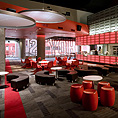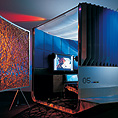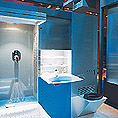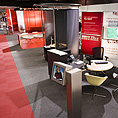











Deus Ex Machina 1989'god out of the machine'Applied originally to the Greek theatrical device of using winches and cranes to facilitate the flight and decent of gods to the stage. This arrival generally turned the play on its head as the gods were want to revive the dead and generally intervene. Later the phrase came to indicate a literary device which fulfilled much the same function - an unexpected event or providential interposition which occurs to resolve a difficult situation. |
Deus Ex Machina was an event which brings together the work of a diverse group of designers, artists and technicians. While the work in question ranges from furniture and appliances through to sculpture, sound and images, it shares a common concern with the relationship betwen man, technology and the machine in the late 20th century. |
In the 50's, American hopes for an impossibly uncomplicated future were carried abroad in the sleek curves of the Cadillacs, the trouble-free folds of polyester and the lurid bondage of plastics. The machine and its products became icons of an optimism which had seemed impossible in the decade before. |
That future soured (inevitably) in the light of the cold war. The machine carried the burden of our disappointment while at the same time becoming a symbol of our worst fears. The real implications of the playful atom symbol (which was so naive yet such an inspiring device) began to dawn, as did the realisation that heavy industry and the march of technology cared little for global economics, political concerns or the environment. |
As we approached the end of the century, the presence of technology in our everyday lives is arguably greater than even the 50's vision anticipated, yet it incorporates a deep ambivalence. |
It is generally accepted that the machines in our lives must be discrete and that where they intrude it is as a feature, like a car, rather than as an homogenous part of the domestic environment. There are complex codes about the degree of 'machineness' a device can exhibit depending on how and where it is used. |
 |
This ambivalence towards technology has become so strong a part of the general psyche that we can begin to see evidence in films, design, art - in fact all media - of sporadic attempts to come to terms with it. Such outbursts of technological anxiety are typified by films like Bladerunner, Terminator and Brazil; by the literature of J.G. Ballard and William Gibson; and the design of Philippe Starck and Shin Takamatsu. |
Deus Ex Machina is not a celebration of the machine but rather an attempt to come to terms with waht seems likely to remain an uneasy alliance between man abd technology. This sense of revealed unease informs all the work in the exhibition. |
Exhibitors |
Deus Ex Machina is a project which comprised of a book, a touring installation/exhibition and a 59 minute compact disc. |
The project was borne out of a need to articulate influences on and the common interests of the individuals concerned. When it became apparent that the lineage of these concerns was consistent, complex and yet somehow out of sync with current thinking within the various disciplines concerned, we were intrigued. There was, we felt, an undeniable yet elusive bond between our work and the work of others which similarly affected us. We set about trying to identify a context in which these things could co-exist as we felt they must. Eschewing all but first generation influences and concentrating on the manifest items rather than the clouds of theorising which seem to engulf them, we proposed, as a tool initially, the list. Later we approached a number of people to participate in this event. We felt able by this stage to convey the concerns of the project and invite contributions from exponents in various fields. |
16 years on from our initial musings, we hope that the project spoke for itself and provided a uniquely Australian perspective on a compelling and universal impulse. |
Jane Joyce |
2008 © Crowd

